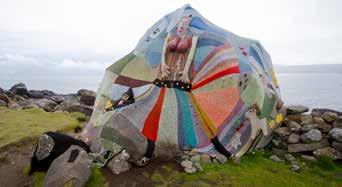
4 minute read
Sandur Søltuvík 17
Sandur Søltuvík
Embark on an adventure in a special landscape filled with dramatic history where you can even feel the witch’s breath on your neck
The route starts at the old school in Sandur . Follow the road Undir Reynum. Continue along the road that says Søltuvíkarvegur.
On the right-hand side of the road, after about 700 metres, you will have your first encounter with the witch. Here, the Gívrinarspor (Witch’s Footprint) is visible in stone .
According to legend, there lived a witch in a hole west of Gróthúsvatn. One day, a man passed the hole and saw the witch grinding gold on a grinder. On the floor, a child was playing with a golden stick. The man grabed the golden stick from the child and fled from the spot on horseback. The witch called

on a neighbouring witch, who ran after the man. She jumped across Gróthúsvatn, and you can still see the imprint of her foot in the stone. There are also imprints of her knuckles in this area.
At Gróthúsvatn, there is a four-metre tall stone that the women of Sandur have decorated with a knitted cover, which is based on the legend of the witch. The stone has a circumference of 18 metres, which means many, many hours of knitting.
Enjoy the view over the beautiful, peaceful Gróthúsvatn. The serene nature of the lake is in stark contrast to the winter waves, which can be quite rough in this area. The sea does not even rest during the summer. Hear the waves relentlessly thunder against the rocks and feel the fresh scent of salt water.
Sandur is one of the oldest villages in the Faroes. The latest archaeological excavations show that people have lived in the village as early as the years 300-400.
From Gróthúsvatn, the path winds uphill, and after approximately one kilometre you will come to Gívrinarhol , a hole where the witch lived. From

Gívrinarhol you can look to the southeast and see the old village of Skarvanes, which was one of the best places in the Faroe Islands to grow grain. You can also see Skúvoy. This was the home of Sigmundur Brestisson (page 58), the Faroese chieftain who, according to the Faroese saga, brought Christianity to the Faroe Islands. Skúvoy is also where his grave is located. From here, you also have a good view of Stóra Dímun, Lítla Dímun and Suðuroy.
From Gívrinarhol and about 300 metres on, you must be careful as the terrain on the road’s left-hand side is steep. After a while it evens out again, and the terrain is flat.
After about three kilometres, the sound of the sea mixes with bird songs from the outfield. First as a slight whisper, but for every metre it deepens into a roar. Slowly, the beautiful bay of Søltuvík reveals itself, surrounded by a collection of rocks that only allow very small boats to come inside when the weather is good.
As beautiful as it is, it can be equally harsh and ruthless. In November 1895, a shipwreck took place in the area. A British steamer, Principia, got caught in a storm and drifted into the rocky area. The ship sank and 28 people drowned. Only one person survived the tragedy. He managed to pull himself up on a cargo hatch and drifted at sea for 14 hours until he was rescued in Kirkjubøur. That same hatch is today used as a table top in Roykstovan on the old farm in Kirkjubøur.
When you follow the road down to the beach, you can see two anchors from Principia that divers retrieved from the ocean floor in 2001. At the site, there is also a memorial stone in memory of the dead. Why walk to Søltuvík when you can drive? You know the answer when you have made the trip. If you drove, Duration: Two and a half to three hours (return)
Distance: Nine to ten km
Difficulty: Easy. Flat terrain most of the way, however, it goes uphill slightly from Gróthúsvatn to Gívrinarhol
Maximum height: 121 m
Children: Suitable for children. However, it is a good idea to hold small, lively children’s hand from Gívrinarhol and about 300 metres forward, as there is a steep left-hand side of the road
Surface: Road with gravel and asphalt
Maps: 406, 407, 506 and 507
you would miss the sound of the roaring waves, the smell of salt water, grass and heather, bird songs and, lastly, the witch’s breath on your neck.
TWO BURNT BARLEY GRAINS
In all likelihood, people have lived in Søltuvík in the 900s. Archaeological records and excavations some years ago found debris from buildings and objects from the settlement. And carbon-14 dating of two burnt barley grains show that they come from a settlement layer from the 900s, i.e. from the Viking Age. The settlement may be from an earlier date because the soil layers with the barley grains date from late in the possible settlement period. How early people may have settled in Søluvík is still unclear.
This is interesting because Søltuvík has never been settled, except for a brief period in 1830 and in the middle of the 1900s. The settlement from the Viking Age was somewhat south of Søltuvíkará by the beach.










